全球变化科学导论
全球变化绪论

对地观测系统
全球气候 观测系统
全球海洋 观测系统
全球陆地 观测系统
地面观测网
气象 水文 生态 海洋 地震
把地球放进实验室--地球系统模式
2. 全球变化科学的研究对象,目标和要 解决的主要科学问题
全球变化研究的对象---地球系统
由大气圈、水圈、岩石圈、冰冻圈和生 物圈(包括人类圈)所组成的作为整体的行 星地球。它是由一系列相互作用过程(包括 系统各圈层之间的相互作用,物理、化学 和生物三大基本过程的相互作用以及人与 地球的相互作用)联系起来的复杂的非线性 多重耦合系统。
全球变化
主讲人:金秉福 鲁东大学地理与规划学院
自地球诞生之日起,它的环境就在不断变 化。在人类出现之前,这种变化纯粹是受 自然推动力支配的。 自人类诞生之日起,人类就开始干预了地 球环境的演变过程。当然,在初始时期人 类对环境的干预是微不足道的。直到工业 革命以前,这种影响还只是局部的。
随着人类社会的发展,人类对环境的影响日益增 长。早在1972年,联合国召开了著名的“人类环 境大会”,号召各国政府关注环境问题。但是, 当时的注意力还仅限于一个国家和一个地区的问 题,其学科范围主要限于地球科学的各个分支。 90年代以来,人类对全球环境问题的严重性、 复杂性以及人类自身对环境影响程度的认识达到 了一个新的高度。全球环境问题已成为人类社会 持续发展所面临的重要而急迫的问题,全球变化 研究成为一个共同关注的“热点”。
全球变化研究的科学目标
描述和理解人类赖以生存的地球系统 运转的机制,它的变化规律以及人类活 动对地球环境的影响,从而提高未来环 境变化的预测能力,为全球环境问题的 宏观决策提供科学依据。
全球变化研究的主要内容
1 全球变化的过程和驱动力 全球变化都是通过一定的过程来实现的, 表现为地球系统中某些关键性过程的变异, 并通过这些过程的变异引起一系列的反馈 过程,最终导致全球环境偏离原有的平衡 状态,即发生全球变化。 全球变化总是由控制地球系统状态的某些 因素的变化引起的,这些驱动因素可能来 自于驱动地球系统运行的地球外力、地球 内力和人类活动,也可能来自于地球系统 内部各子系统的相互作用。
第三章 全球变化研究方法
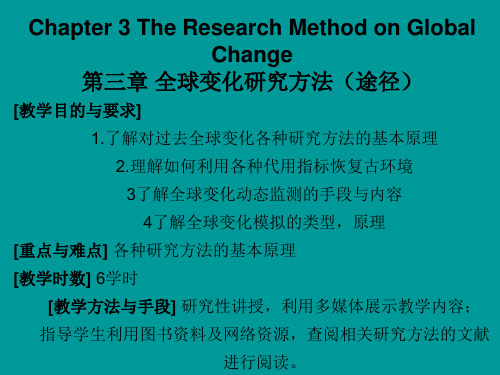
[教学目的与要求]
1.了解对过去全球变化各种研究方法的基本原理 2.理解如何利用各种代用指标恢复古环境
3了解全球变化动态监测的手段与内容
4了解全球变化模拟的类型,原理 [重点与难点] 各种研究方法的基本原理 [教学时数] 6学时 [教学方法与手段] 研究性讲授,利用多媒体展示教学内容;
黄土沉积特征
• 第四纪黄土沉积以黄土层和古土壤层交互沉积为特征。黄土层的 形成反映风尘堆积作用过程,而古土壤层的形成反映成土作用过 程。当风尘堆积作用大于成土作用时形成黄土层,反之,形成古 土壤层。 • 黄土沉积与寒冷的冰期相对应,古土壤与相对温暖的间冰期相对 应。 • 我国黄土主要分布在干旱荒漠区的外缘,表明黄土沉积时期当地 属于干寒草原环境,而古土壤发育时期则对应温暖的森林草原环 境。 • 黄土与古土壤层的交替变化是第四纪冰期---间冰期环境周期性变 化的反映。 • 根据黄土层的风化程度和古土壤发育程度的差别,推断环境在不 同时期的差别。 • 黄土—古土壤序列是目前已知的唯一能与深海氧同位素记录对比 的陆上沉积。两者有很好的对应关系。
• [参考书目]
• 朱诚,谢志仁,申洪源. 全球变化科学导论(An Introduction to Global Change Science). 南京: 南京大学出版社,2003.
• [课堂训练、作业思考题]
• 课堂训练:用多媒体手段指导学生利用图书馆资料及网 络资源,查阅相关书籍及期刊文献,了解现在全球变化 研究中目前的最新进展 • 作业思考题 • 1.反映全球变化的记录有哪些?如何利用这些指标重建 过去的全球环境变化?
全球变化导论复习整理

全球变化导论复习整理全球变化导论复习资料考试题⽬类型:(1)名词解释(每题4分,共20分);(2)填空题(每个空格1分,共20分);(3)简答题(每题6分,共24分);(4)问答题(每题10分,共20分);(5)论述题(1题,16分)。
重点掌握的内容⼀、知识部分:1.地球系统由⼤⽓圈,⽔圈,岩⽯圈,冰冻圈和⽣物圈(包括⼈类圈)所组成的作为整体的⾏星地球.它是由⼀系列相互作⽤过程(包括系统各圈层之间的相互作⽤,物理、化学和⽣物三⼤基本过程的相互作⽤以及⼈与地球的相互作⽤)联系起来的复杂的⾮线性多重耦合系统。
(*是全球变化科学的研究对象)2.全球变化科学研究作为整体的地球系统的运⾏机制、变化规律和控制变化的机理(⾃然的和⼈为的),并预测未来变化的科学。
3.地球系统科学研究地球系统各组成部分之间的相互作⽤,以及发⽣在地球系统内的物理、化学和⽣物过程之间的相互作⽤的⼀门新兴科学。
4.地球系统的三⼤循环:⽔循环、⽣物地球化学循环、固体地球物质循环。
5.地球系统三个⼦系统(1)物理⽓候系统——⼤⽓圈、⽔圈为主(决定地球表层⽔分、能量交换和分布,形成全球⽓候);(2)固体地球系统——岩⽯圈为主(决定地层⽣消及运动,形成地球海陆分布与地貌形态);(3)全球⽣态系统——⽣物、⽣命⽀持系统。
6.地球系统的三类过程:物理过程、化学过程、⽣物过程,这些过程是有机联系的整体。
7.物理⽓候系统包括:⼤⽓、海洋、冰雪、陆地表⾯和⽣物圈。
(太阳能是物理⽓候系统的驱动⼒。
)8.影响⽓候系统加热率的影响因素:太阳辐射强度及地球轨道要素;地球⾏星反射率;太阳能在地球系统中滞留的时间。
9.温室⽓体:温室⽓体指的是⼤⽓中能吸收地⾯反射的太阳辐射,并重新发射辐射的⼀些⽓体,如⽔蒸汽、⼆氧化碳、⼤部分制冷剂等。
(⽔汽、CO2、N2O、CH4、O3、氟氯烃等)10.⼤⽓环流包括:⼤⽓平均经圈环流、沃克环流、季风环流。
11.海洋环流包括:表层环流、深海环流(热盐环流)。
全球变化第二章全球变化的主要过程与驱动力概要
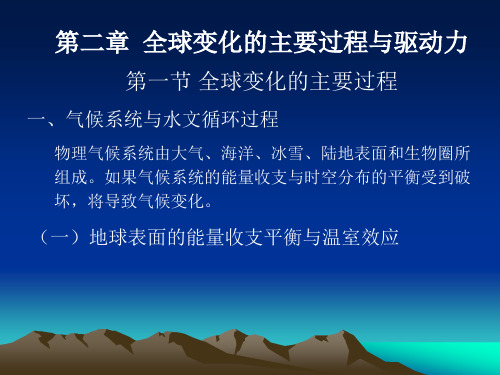
由于行星的摄动作用,黄赤交角发生周期性 的变化。现代黄赤交角是23°27′,在几百万年 内,黄赤交角的变化范围为21°39′~24°36′, 变化周期约40ka。这一变化被比喻为好像船的 左右摇摆。黄赤交角影响地球上不同纬度和不 同季节的气候差异程度的大小,黄赤交角越大, 冬季和夏季的差异越大。黄赤交角变化对极区 影响最大,若黄赤交角减小,极地地区变暖, 反之,极地地区更为寒冷。
地球绕太阳运转的轨道呈椭圆形,太阳位于椭圆轨 道的一个焦点上,轨道偏离正圆的程度就是地球轨道 的偏心率。偏心率以10万年变化于0.005~0.06之间, 同 时 还 存 在 40 万 年 的 周 期 变 化 。 目 前 的 偏 心 率 为 0.0167,地球分别处于近日点和远日点时,日照量的 差别为7%,偏心率愈大,差异愈大。
在无机环境中,碳主要以CO2或者碳酸盐和重碳酸盐的 形式存在。生态系统中的碳循环基本上是伴随着光合、呼 吸和分解过程进行的,在较长的时间尺度上,地质因素对 于碳循环也是重要的,因为贮存在沉积岩中的大量碳(煤、 石油和天然气等)是生态系统在过去年代中所固定的,它 们暂时退出了生物圈活跃的生物地球化学循环。自然界碳 的活动贮存库主要是海洋、大气和有机体。
二、固体地球系统与岩石圈循环过程
(一)板块运动过程 (二)陆上风化与侵蚀堆积过程 (三)海洋沉积过程
三、生态系统与生物地球化学循环过程
全球碳循环(IPCC,1996)
大气中及溶解在河流、湖泊和海洋等水体中的CO2,是 可供生物圈利用的主要无机碳源,陆上植物和海洋浮游植 物等有机物通过对CO2的光合作用而捕获太阳能为生物圈 提供能量,同时使得碳进入生物圈,并向大气提供氧气。
太阳活动是太阳表面上一切扰动现象的总称。主要包括:发 生在光球表面的黑子、光斑,发生在色球层的谱斑、耀斑,以及 日珥、日冕等。一般用黑子活动代表太阳活动,黑子越多,太阳 活动越强,其他太阳活动都和黑子活动呈同步变化,太阳常数的
全球变化之全球变化科学导论(大气所考博真题知识点归纳)

《全球变化科学导论》要点总结第一篇全球变化研究的基本问题第一章全球变化科学产生的背景及其研究内容及意义1、什么是全球变化?其产生背景?答:全球变化作为一个科学术语和一门交叉学科,是随着全球环境问题的出现和人类对其认识程度的不断深化而提出并发展起来的。
全球变化科学的精髓是系统地球观,强调将地球的各个组成部分作为统一的整体来加以考察和研究,将大气圈、水圈、岩石圈和生物圈之间的相互作用和地球上的物理的、化学的和生物的基本过程之间的相互作用,以及人类与地球之间的相互作用联系起来进行综合集成研究。
即全球变化科学是研究作为整体的地球系统的运行机制、变化规律和控制变化的机理(自然的和人为的),并预测其未来变化的科学。
它研究的首先是一个行星尺度的问题——将大气圈、水圈(含冰雪圈)、岩石圈和生物圈看成是有机联系的全球系统,把太阳和地球内部作为两个主要的自然驱动器,人类活动作为第三种驱动机制。
发生在该系统中的全球变化是在上述驱动力的推动下,通过物理、化学和生物学过程相互作用的结果。
全球变化科学是在时代发展、科学进步、人类活动的强烈影响和社会需要的背景下产生的,主要表现在以下几个方面:(1)硬件条件。
在20世纪末,全球国际性应用的探测器和预测预报系统已有约1000个高空站、10000个气象站、3000个飞行器、7000艘充气船、500个浮标、长期立体动态信息库,还有全球海洋观测系统、全球陆地观测系统、全球气候观测系统。
(2)由于强烈的人类活动和社会经济的飞速发展,目前在全球范围内产生以下十大环境问题,急需国际社会合作共同解决。
主要有大气污染、温室气体排放和气候变暖、臭氧层破坏、土地退化、水资源匮乏和水体污染、海洋环境恶化、森林锐减、物种濒危、垃圾成灾、人口增长过快。
(3)从人类社会文明发展看,全球变化科学的产生是历史进程的必然。
(4)从历史发展角度看,全球变化研究有其科学思想的代表。
亚里士多德第一次提出支持生命的物理系统;加兰第一次提出地球系统科学的概念;弗里德曼第一次提出“全球变化”概念,从此人类开始从交叉学科角度将地球作为全球系统开展研究。
福建师范大学 全球变化导论复习
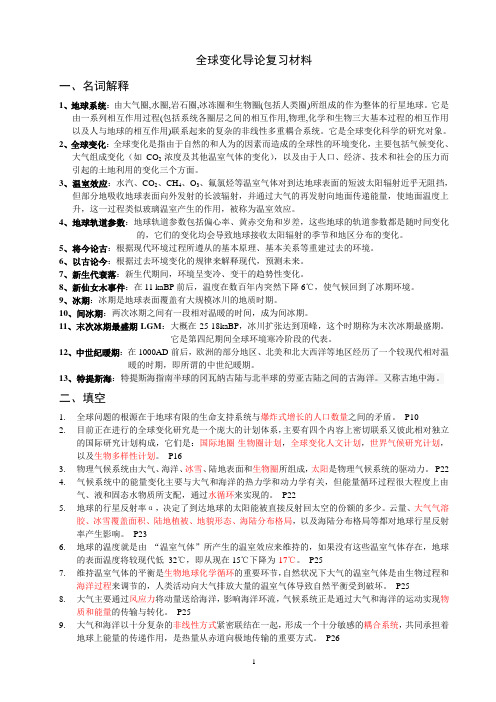
全球变化导论复习材料一、名词解释1、地球系统:由大气圈,水圈,岩石圈,冰冻圈和生物圈(包括人类圈)所组成的作为整体的行星地球。
它是由一系列相互作用过程(包括系统各圈层之间的相互作用,物理,化学和生物三大基本过程的相互作用以及人与地球的相互作用)联系起来的复杂的非线性多重耦合系统。
它是全球变化科学的研究对象。
2、全球变化:全球变化是指由于自然的和人为的因素而造成的全球性的环境变化,主要包括气候变化、大气组成变化(如CO2浓度及其他温室气体的变化),以及由于人口、经济、技术和社会的压力而引起的土地利用的变化三个方面。
3、温室效应:水汽、CO2、CH4、O3、氟氯烃等温室气体对到达地球表面的短波太阳辐射近乎无阻挡,但部分地吸收地球表面向外发射的长波辐射,并通过大气的再发射向地面传递能量,使地面温度上升,这一过程类似玻璃温室产生的作用,被称为温室效应。
4、地球轨道参数:地球轨道参数包括偏心率、黄赤交角和岁差,这些地球的轨道参数都是随时间变化的,它们的变化均会导致地球接收太阳辐射的季节和地区分布的变化。
5、将今论古:根据现代环境过程所遵从的基本原理、基本关系等重建过去的环境。
6、以古论今:根据过去环境变化的规律来解释现代,预测未来。
7、新生代衰落:新生代期间,环境呈变冷、变干的趋势性变化。
8、新仙女木事件:在11 kaBP前后,温度在数百年内突然下降6℃,使气候回到了冰期环境。
9、冰期:冰期是地球表面覆盖有大规模冰川的地质时期。
10、间冰期:两次冰期之间有一段相对温暖的时间,成为间冰期。
11、末次冰期最盛期LGM:大概在25-18kaBP,冰川扩张达到顶峰,这个时期称为末次冰期最盛期。
它是第四纪期间全球环境寒冷阶段的代表。
12、中世纪暖期:在1000AD前后,欧洲的部分地区、北美和北大西洋等地区经历了一个较现代相对温暖的时期,即所谓的中世纪暖期。
13、特提斯海:特提斯海指南半球的冈瓦纳古陆与北半球的劳亚古陆之间的古海洋。
全球变化-第一章
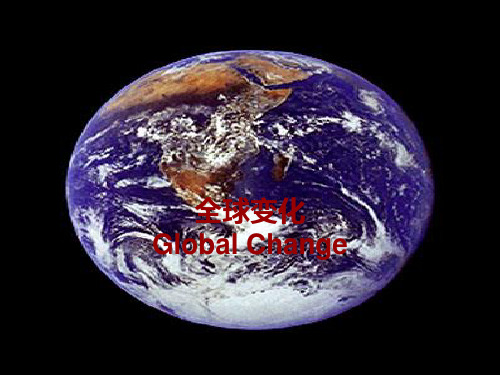
三、地球系统的物质和能量转化
地球系统中物质和能量的转换与交换是通过一系列的过程 来实现的。这些过程按其性质可分为物理过程、化学过程 和生物过程三种类型。地球系统的过程是地球系统中由物 理、化学或生物学规律所支配的那些现象的集合。以全球 碳循环为列。
❖ 地球系统中的物理过程、化学过程和生物过程是有机联系 的整体。
❖ 不同的地球系统过程具有不同的时间和空间尺度,通常用 10 n表示。
尺度
四、地球系统的驱动力
地球系统的驱动力
太阳和其他外力 (人类活动)
放射性和内部深处的原生热
在以上两个驱动力的相互作用下,地球表层产生了复 杂的循环过程。人类在其发展进化的进程中,为了自 身的生存和发展,逐步用人类所驯化的植物和动物组 成的生态系统以及几乎全部由人类自己构建的城市体 系来代替自然生态系统,使人类生态系统逐渐成为地 球环境中不可忽视的重要组成部分,由此成为影响地 球系统状态、引起全球变化的一个重要因素。
二、全球变化研究的主要内容
2、全球环境变化在时间上和空间上的 表现形式
从时间过程上看,全球环境变化表现为一个 时期环境的状态或其特征值较另一时期有明显不 同。
全球变化在不同地区均会有所反映,但不同 地区响应全球变化的方式可以各不相向,可以存 在着彼此不同的过程。
二、全球变化研究的主要内容
3、全球变化的影响和人类的响应
国内:《吕氏春秋》《水经注》
二、科学的全球变化研究的起步与发展
70年代
人类社会、经济、政治变化
80年代
第一讲全球变化科学导论

World population
World population will reach 6,000 million during 1999 - but the rate of growth has begun to slow.
Population
Source: compiled by UNEP GRID Geneva from United Nations Population Division 1996
全球水,碳循环,食物系统
全球变化科学是怎样产生的?
全球变化科学的研究对象,目标和要解决的 主要科学问题
全球变化科学的学科性质,特点和研究方法
人类生存的地球环境正在发生那些重大变化
• 气候的变化 温度升高 • 大气成分的变化 二氧化碳和其它温室气体、气溶胶含量
的增加, 臭氧洞
• • • • • •
Europe
North America
South America
Urban population
Source: compiled by UNEP GRID Geneva from United Nations Population Division 1997 and WRI, UNEP, UNDP and WB 1998
(millions of hectares degraded)
Vegetation Removal Overexploitation Overgrazing Agricultural Activities Industrial and Bioindustrial
579 133 679 522 23
World
Asia and Oceania Latin America and Caribbean
《全球变化》教学大纲
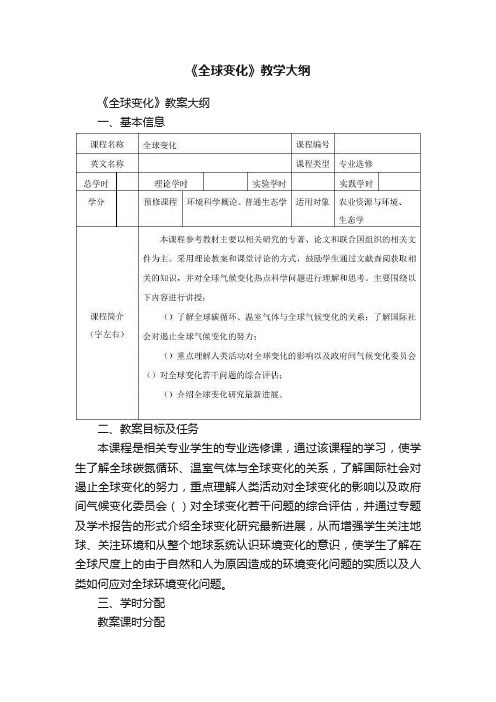
《全球变化》教学大纲《全球变化》教案大纲一、基本信息二、教案目标及任务本课程是相关专业学生的专业选修课,通过该课程的学习,使学生了解全球碳氮循环、温室气体与全球变化的关系,了解国际社会对遏止全球变化的努力,重点理解人类活动对全球变化的影响以及政府间气候变化委员会()对全球变化若干问题的综合评估,并通过专题及学术报告的形式介绍全球变化研究最新进展,从而增强学生关注地球、关注环境和从整个地球系统认识环境变化的意识,使学生了解在全球尺度上的由于自然和人为原因造成的环境变化问题的实质以及人类如何应对全球环境变化问题。
三、学时分配教案课时分配四、教案内容及教案要求第一章绪论第一节地球系统、地球系统概念的形成、地球系统中的主要科学问题习题要点:地球系统概念、物理气候系统、生物地球化学循环、时间、空间尺度第二节全球碳库、大气碳库、海洋碳库、陆地生态系统中的碳、土壤碳库习题要点:全球碳库的构成第三节地球系统碳循环、基本概念、研究史、碳过程与碳循环习题要点:地球系统碳循环的主要过程第四节全球变化、全球变化概述、全球变暖的事实、温室气体与温室效应习题要点:全球变化概念、全球变暖的事实、温室效应概念、温室气体类型第五节碳循环与全球变化、碳排放在温室效应中的地位、温室气体与碳的“源”与“汇”、碳减排问题实质习题要点:碳与温室效应的关系、温室气体的源汇效应、全球变化与碳减排本章重点、难点:全球各个碳库的认识及全球变化的概念,碳循环与全球变化的关系。
本章教案要求:本章要求学生了解地球系统的概念及地球系统科学研究中相关的主要科学问题,理解全球变化及温室效应的概念,并理解地球系统中的主要碳库构成及在不同时空尺度上所发生的各种生物地球化学、物理循环过程,掌握全球变化及温室效应与地球系统碳库、碳循环的关系。
第二章大气中的温室气体第一节大气温室气体浓度、变化趋势及其源汇分布、大气、大气、大气、其它温室气体习题要点:《京都议定书》及其规定消减的种温室气体、、和的主要源和汇、、“蒙特利尔议定书”。
全球变化

全球变化导论复习材料1.全球变化的定义及内涵全球变化:全球环境(包括气候、土地生命力、海洋和其他水资源、大气化学及生态系统等)中的、能改变地球承载生命的能力的变化。
全球变化:是指由于自然的和人为的因素而造成的全球性的环境变化,主要包括气候变化、大气组成变化(如CO2浓度及其他温室气体的变化),以及由于人口、经济、技术和社会的压力而引起的土地利用的变化三个方面。
2.全球变化研究的对象---地球系统由大气圈,水圈,岩石圈,冰冻圈和生物圈(包括人类圈)所组成的作为整体的行星地球.它是由一系列相互作用过程(包括系统各圈层之间的相互作用,物理,化学和生物三大基本过程的相互作用以及人与地球的相互作用)联系起来的复杂的非线性多重耦合系统。
3.全球变化研究的科学目标描述和理解人类赖以生存的地球系统运转的机制,它的变化规律以及人类活动对地球环境的影响,从而提高未来环境变化的预测能力,为全球环境问题的宏观决策提供科学依据.4.全球变化研究的内容全球变化的过程和驱动力;全球变化在时间和空间上的表现;全球变化对人类的影响与人类的响应;全球变化信息的获取、处理与分析技术5.大地女神假说(Gaia Hypothesis)Gaia假说的主要论点地球上所有生物都在起着调节作用:只根据物理学和化学规律是很难解释的,必须同时考虑生物学规律。
地球生态系统保持稳定性:地球大气的组成、气温、海水温度、海水pH值等都是由生物圈积极通过自己的影响使地球的气候环境长期保持在适合自己的“稳态”上。
地球生态系统是一种进化系统地球生态系统是一个整体(大地女神)具有新陈代谢功能——地球生理学(geophysiology)6.冰期-间冰期的转换机制一、地球轨道参数变化深海氧同位素序列和黄土古土壤序列中可检测出地球轨道参数变化的特征周期。
说明地球轨道参数变化可能是第四纪环境周期变化的驱动力在不同阶段,起主导作用的周期有明显差别:1.6-2.5MaBP期间,以偏心率周期(0.1Ma、0.4Ma)较明显,其它周期不明显0.9-1.6MaBP期间,以黄赤交角周期(41ka)较明显,其它周期不明显0.9BP以来,0.1Ma周期成为主要周期7.米兰柯维奇理论能否完美解释冰期间冰期的转换?偏心率变化(0.9MaBP以来)引起的太阳辐射变化分量不足以解释温度的大幅度变化不能解释地球温度变化在时相上落后于太阳辐射变化,以及转换过程的其它时滞现象不能解释转换过程中的不对称性不能解释快速变化事件8.撒哈拉地区畜牧业文化的兴衰全新世之初,受到季风增强影响的撒哈拉沙漠和亚洲的类似地区,均是巨大的绿色地带,现代的撒哈拉沙漠中曾经是人类活动的场所。
全球变化
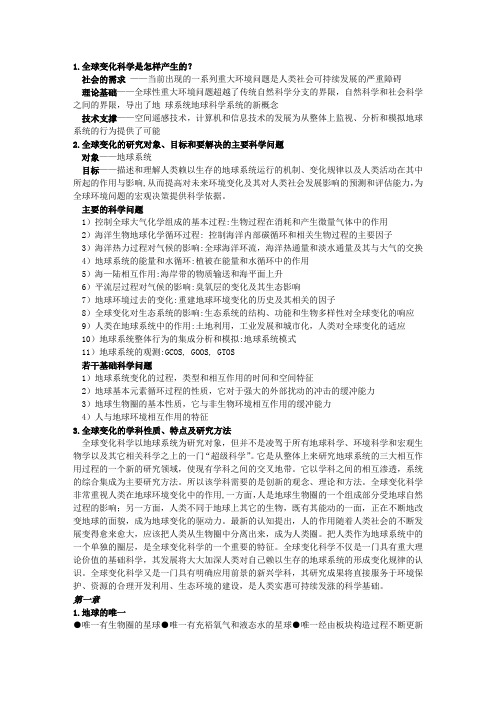
1.全球变化科学是怎样产生的?社会的需求——当前出现的一系列重大环境问题是人类社会可持续发展的严重障碍理论基础——全球性重大环境问题超越了传统自然科学分支的界限,自然科学和社会科学之间的界限,导出了地球系统地球科学系统的新概念技术支撑——空间遥感技术,计算机和信息技术的发展为从整体上监视、分析和模拟地球系统的行为提供了可能2.全球变化的研究对象、目标和要解决的主要科学问题对象——地球系统目标——描述和理解人类赖以生存的地球系统运行的机制、变化规律以及人类活动在其中所起的作用与影响,从而提高对未来环境变化及其对人类社会发展影响的预测和评估能力,为全球环境问题的宏观决策提供科学依据。
主要的科学问题1)控制全球大气化学组成的基本过程:生物过程在消耗和产生微量气体中的作用2)海洋生物地球化学循环过程: 控制海洋内部碳循环和相关生物过程的主要因子3)海洋热力过程对气候的影响:全球海洋环流,海洋热通量和淡水通量及其与大气的交换 4)地球系统的能量和水循环:植被在能量和水循环中的作用5)海—陆相互作用:海岸带的物质输送和海平面上升6)平流层过程对气候的影响:臭氧层的变化及其生态影响7)地球环境过去的变化:重建地球环境变化的历史及其相关的因子8)全球变化对生态系统的影响:生态系统的结构、功能和生物多样性对全球变化的响应 9)人类在地球系统中的作用:土地利用,工业发展和城市化,人类对全球变化的适应10)地球系统整体行为的集成分析和模拟:地球系统模式11)地球系统的观测:GCOS, GOOS, GTOS若干基础科学问题1)地球系统变化的过程,类型和相互作用的时间和空间特征2)地球基本元素循环过程的性质,它对于强大的外部扰动的冲击的缓冲能力3)地球生物圈的基本性质,它与非生物环境相互作用的缓冲能力4)人与地球环境相互作用的特征3.全球变化的学科性质、特点及研究方法全球变化科学以地球系统为研究对象,但并不是凌驾于所有地球科学、环境科学和宏观生物学以及其它相关科学之上的一门“超级科学”。
全球变化第一章地球系统与全球变化
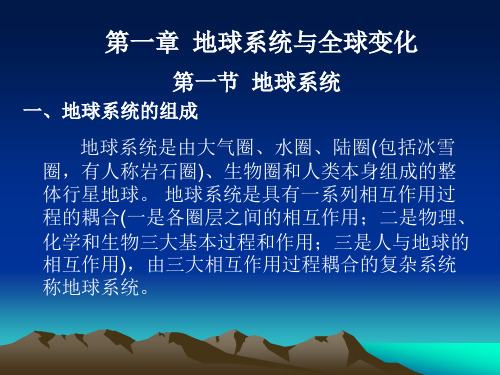
第一节 地球系统
一、地球系统的组成
地球系统是由大气圈、水圈、陆圈(包括冰雪 圈,有人称岩石圈)、生物圈和人类本身组成的整 体行星地球。 地球系统是具有一系列相互作用过 程的耦合(一是各圈层之间的相互作用;二是物理、 化学和生物三大基本过程和作用;三是人与地球的 相互作用),由三大相互作用过程耦合的复杂系统 称地球系统。
1915年大陆漂移学说提出;1920年米兰科维奇天文理论提出;1930年臭 氧层学说提出;1948年第一个数值天气预报产生;1957年国际地球物理 年(开始第一次多学科合作、大规模开展观测);1960年第一张全球卫星 图片诞生;1969年人类登月成功。此外,还有臭氧洞的发现、海事卫星 的发射和成功使用,直至1986年国际地圈生物圈计划的制定和实施。也 就是说,全球变化研究实际上是上述20世纪以来地球科学发展的里程碑 之一。
2.硬件条件。在20世纪末全球国际性应用的探测器和预测预报 系统已有约1 000个高空站、10 000个气象站、3 000个飞行 器、 7 000艘充气船、500个浮标、长期立体动态信息库,还有 全球海洋观测系统、全球陆地观测系统、全球气候观测系统。
3.从社会需要角度来看,目前公认存在十大环境问题急需国 际合作共同解决。
三、全球变化研究的意义
1.全球变化研究是人类社会实现可持续发展的科学基础。
2.深化对地球系统的认识,促进地球科学发展
3.改变人类的观念、促进应用基础科学和有关社会科学 的发展。 4.推动世界科学进步、促进世界和平
第三节 全球变化研究的历史、现状和趋势
一、全球变化研究历史
全球变化研究科学是在时代的发展、科学的进步、社会的需 要情况下产生的,主要表现在以下几个方面: 1.从人类社会文明发展的进程看,全球变化研究科学的产生 是历史的必然。1905年发现电离层;1906年发明放射性同位素测年;
- 1、下载文档前请自行甄别文档内容的完整性,平台不提供额外的编辑、内容补充、找答案等附加服务。
- 2、"仅部分预览"的文档,不可在线预览部分如存在完整性等问题,可反馈申请退款(可完整预览的文档不适用该条件!)。
- 3、如文档侵犯您的权益,请联系客服反馈,我们会尽快为您处理(人工客服工作时间:9:00-18:30)。
0
500
1000
1500
2000
2500
3000
3500
70年代以来北非地区连年干旱使22个国家的 2亿5千万人口遭受本世纪最严重的粮食危机
北方干旱化
极端 干旱
干旱
半 干旱
干旱半干旱区占国土面积40%。 90年代以来,北方干旱化有关的灾害 造成的经济损失每年在1000亿元以上。
黄河断流
断流天数 断流长度
干旱化使 90 年代黄河中上游的年天然径流量比 50年 代减少了24.4% ,在自然过程和人 类活动的共同作用下 24.4% 68% ,下游实际径流量减少 68%,致使黄河连年断流,每经 济损失超过100亿 ,其中胜利油田产量减少8% 。 8% 100 亿元
频繁发生的自然灾害
Water Demand is Growing, But Supplies Are Limited
World Africa Europe Asia South America Central America North America Oceania
Percentage of Water Resources
Source: ISRIC/UNEP/FAO 1997
40 年 来 中 国 荒 漠 化 的 扩 展 范 围
引自董光荣等
Arable land per capita
Source: compiled by UNEP GRID Geneva from FAOSTAT 1997
水资源短缺
20世纪以来,全球 消耗的水量增加了 6倍 目前世界上 20亿 人口面临缺水困难 估计到2025年,缺 水将危及一半以上 的世界人口
Carbon dioxide emissions per capita
Source: compiled by UNEP GRID Geneva from CAIAC 1998 and WRI, UNEP, UNDP and WB 1998
More fertilizer: (N) More food, but more pollution too
World Africa North and South America Central America Asia
Vegetation Removal Overexploitation Overgrazing Agricultural Activities Industrial and Bioindustrial
荒漠化土地占全球约1/4的 面积,并正以每年600万公 顷的速度推进
Degraded Soil Means Less Food
World Totals (million hectares)
(millions of hectares degraded)
350 300 250 20,水资源短缺 干旱和洪涝灾害发生频率增加 人口增长和城市化
快速变化的全球环境:全球增暖
北半球表面的平均温度的异常(dgC) 20世纪是14世 纪以来最暖的 世纪,全球平均 温度升高了 0.60 C+/-0.2. 90年代是本世 纪最暖的十年
引自Nature
1998
1920's
Fertilizer use
Source: compiled by UNEP GRID Geneva from FAOSTAT 1997
SO2 emissions in Asia could triple
(million metric tons per year)
120 100 80 60 40 20 0 1990 Europe 2000 2010 2020 Asia
Europe
Asia
North America
South America
Urban population
Source: compiled by UNEP GRID Geneva from United Nations Population Division 1997 and WRI, UNEP, UNDP and WB 1998
Integrated Earth Systemn
大气中温室气体含量和污染物迅速增长
1750年以来CO2 增加了31%,近百 年来,由于人类 活动而排放到大 气中的CO2每年 大约为30亿吨. CH4增了151% NO增加了17% 对流层O3增加 了36%
Global carbon dioxide emissions
EL NINO 和旱涝灾害
SST ANOMALIES
NOV.
-OCT 97
98
Total damage of whole valley flood disasters of Yangtze river,1998
Disaster affected population Died people Collapsed houses Disaster affected farmland 240 million 2000 person 5.58 million unit 21.53 million ha
全球水,碳循环,食物系统
全球变化科学是怎样产生的?
全球变化科学的研究对象,目标和要解决的 主要科学问题
全球变化科学的学科性质,特点和研究方法
人类生存的地球环境正在发生那些重大变化
• 气候的变化 温度升高 • 大气成分的变化 二氧化碳和其它温室气体、气溶胶含量
的增加, 臭氧洞
• 土地覆盖的变化 热带雨林和草原的破坏,荒漠化 • 海洋的变化 海面温度 海平面上升 • 生物多样性的变化 物种消失 • 陆地水体的变化 • 自然灾害的变化 • 人类社会的变化
160 140 120 100 80 60 40 20 0 1961 Africa Asia South and Central America Europe North America Oceania World
(million metric tons)
1966
1971
1976
1981
1986
1991
18,000,000 16,000,000 14,000,000 12,000,000 10,000,000 8,000,000 6,000,000 4,000,000 2,000,000 0
Russia and Europe
Cleared
Non Frontier Forest
Frontier Forest
全球变化科学导论
第一讲
全球变化科学
(GLOBAL CHANGE SCIENCE) 20世纪80年代开始形成的新兴科学领域
1984年第一次全球变化国际会议,加拿大OTTAWA
当前发展最为迅速,最为活跃的前沿科学领域 之一
四大国际计划,数百个研究项目,数以万计的科学家,每年数 拾亿美元的投入
21世纪人类社会可持续发展的科学投资
年
Kilimanjaro 1970
Kilimanjaro 2000
Ice on Kilimanjaro
Area (km2)
15 10 5 0 1900
1920
1940
1960 Year
1980
2000
2020
L.Thompson, in prep.
Kilimanjaro 2020
Aan An A
Latin America
World
The expansion of agricultural land since 11 Century B.C over China
11 CE.B.C . 1 CE.B.C.
6-8 CE. A.D. . 14-19 CE.A.D..
土地退化和荒漠化
全球土地的退化率达到 24%,亚州更为严重,高达 31%
among these, 4.48 million ha with no yield Funds from government for mitigation 2.2 billion yuan 6 stations of Yangtze river have broken their historical records of water level
Neville Nicholls, BMRC,Australia
人口快速增长和城市化
过去300年内全球人口增长了10倍 从6亿增加到60亿. 其中城市人口增长最快,19世纪初只有3%的居住在超 过5000人的城市里,20世纪初,14%的人口住在城 里.1991年50%以上为城市人口. 目前世界城市人口的 增长率占2.6%,其中发展中国家的增长率为3.4%,亚州 最快达4.8% 人口的增长和城市化,带来了新的资源和环境问题
(millions of square kilometers)
Asia
North & South America
South America
Africa
Oceania
Forest Loss Is Severe in the Tropics
50 40
(percent)
30 20 10 0
Asia
Africa
Global population continues to rise
Population (billions)
10 8 6 4 2 0
1950 1960 1970 1980 1990 2000 2010 2020 2030 2040 2050
Africa Europe North America
World population
World population will reach 6,000 million during 1999 - but the rate of growth has begun to slow.
